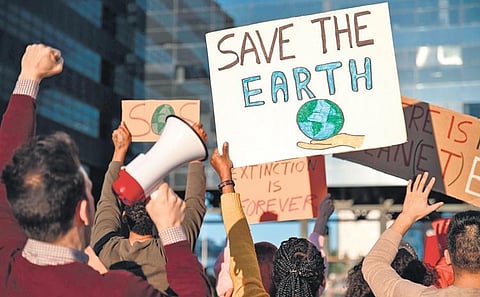

The world is setting alarming records on high temperatures and rise of emissions. Global warming temporarily breached the 2 ° C limit on Nov 19 as a timely warning to humanity just days before COP28. This week’s UN ‘Emissions gap’ report highlights that emissions have increased by 1.2% compared to 2021 and the world is hurtling towards a 2.5-2.9 ° temperature rise if predicted 2030 emissions across the world are not cut by an average 30-40%. When the UN COP starts in Dubai next week, it will be a test of how much governments and large carbon-emitting companies are willing to acknowledge climate impacts as a key element of the polycrisis the world is in and bring the political will to fight the climate crisis.
Tasked with a formal evaluation of the hits and misses of the Paris Agreement, also known as the Global Stocktake, this meeting will be arguably one of the most consequential for international climate efforts. It will be a moment to reflect on collective action and ratcheting up ambition. Over the last 20 years electricity consumption in India has almost tripled. The surge is largely attributed to urbanisation and increasing household incomes. As India continues its growth trajectory, there will be increased power demand. Making sure that growth aspirations are met without emitting more carbon is a decision which will need to be taken at every step of the way.
Electrifying buildings, transport and industry will become the norm. Achieving deep decarbonisation for some of the industries through renewables is theoretically possible but it will come at great costs — economically, with the higher prices passed down to the end consumer, and in terms of the logistics of re-skilling and compensating those affected by the shift. COP28 will instead likely discuss softer alternatives: Carbon Capture and Storage (CCS), conventional nuclear and small modular reactors (SMRs), and possibly greater commitments to green hydrogen.
Next week most likely the oil industry and major fossil fuel-producing countries will make a case for ‘abatement’ and ‘carbon management’ as a preferred means to achieve decarbonisation. CCS is a much talked about solution but at best experts say it’s a limited solution. The IPCC acknowledges the limited role of CCS as leaks are inevitable and private companies can’t bear the risks of such untested technologies. Secondly, CCS was invented 50 years ago and is still nowhere near commercially viable. With multiple feasibility constraints and adverse impacts on human and environmental rights, CCS will always have limited use even if it will be projected as a large part of the solution.
Interest in nuclear power is on the rise too because of its ability to provide direct emissions-free baseload power and ramp-up capacities. China accounts for about 44% of all new demand, India accounts for 12% and overall 85% of the new interest stems from outside West Europe and North America — the stronghold of nuclear capacity till today. However, the idea to pack nuclear reactors into smaller units through SMRs is controversial. Critics argue that the reactors will not achieve the theorised cost reductions per kW. Reports also indicate that the power from the SMRs in China, Russia and Argentina costs more than from the giant, traditional reactors. Yet SMRs have more than 70 approved designs at the moment and large energy consumers, including Japan and Canada, are looking to set them up.
These developments stress the dichotomy of the global energy market. Emissions must be slashed urgently, but taking away the access to predictable power supplies may actually worsen the attempts at development and climate mitigation. More investment in fossil-like fuels, such as 100% green hydrogen, will be critical for the industrial hard-to-abate sectors and unlocking public and private investments will be the key. Renewables backed by energy storage would be good substitutes for residential and commercial applications while the majority of road freight vehicles can be converted to electric. Europe’s electric truck market is set to multiple 25-fold to reach 6,00,000 units by 2030 and globally the segment is expected to grow at a brisk 31.3% CAGR till 2032.
Meanwhile the cost of battery energy storage has dropped by 85% in the last decade; an additional 47% is expected by 2030. This would possibly make renewable energy by far the cheapest source of power across the G20 and lead to truly green electric vehicles. The COP28 will likely be remembered for the flash points between the developed and developing countries. The delegates are expected to have a gruelling two weeks, but the overarching goal must be to arrive at compromises that forward our capacity to lower emissions. 2023 was the hottest year on record and all projections indicate that things will get worse. The point is, if ExxonMobil can ask to become a major player in the switch to sustainability, there should be the scope for the oil and gas industry as whole to come good on its offer. At this point no ally must be rebuffed if a collaboration leads to real and major reductions in emissions.
As the debate about fossil fuels gets heated towards the COP, the questions to answer are not which countries will cut their fossil assets. It is how much collective and collaborative finance can be mobilised so that the new energy demand is purely met by clean renewables, thereby slowly and non disruptively phasing down the fuels of the past as a matter of evolving and differentiated responsibility of countries across the world. Feels like a tall order!
By Aarti Khosla, Founder & Director, Climate Trends
Aniruddha Bhattacharjee, Senior Researcher, Climate Trends